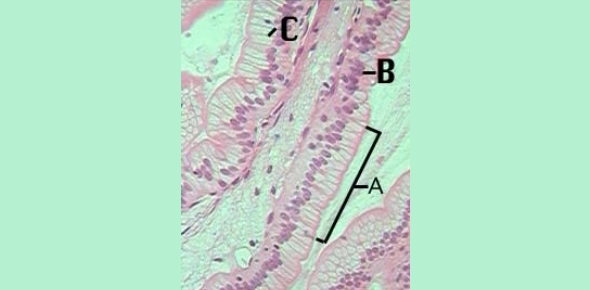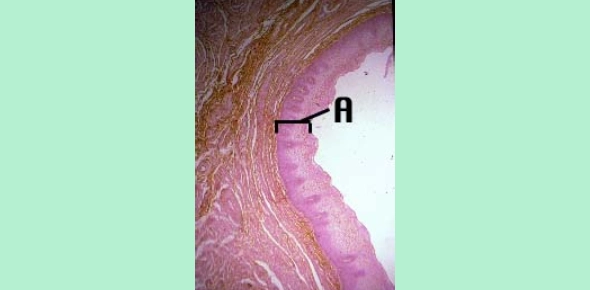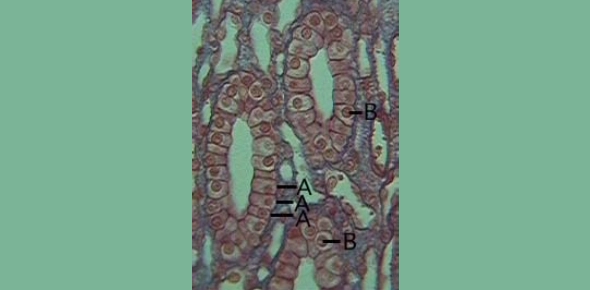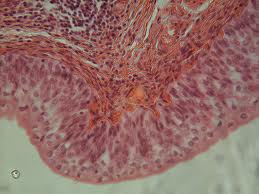Epithelial Tissue Identification Test
(157).jpg)
Welcome to the electronic frontier human anatomy and physiology classroom of the 21st century. This test will identify your strengths to identify different types of epithelial tissues. I wish you good luck in your education as it relates to future human anatomy and possible entry into the medical field.
When a fill-in type question appears in this test, please enter your answer(s) using all lower case letters.
I wish you the best of luck and earn high grade on this test!
- 1.
Please identify the type of epithelial tissue in the image below.
- A.
Stratified Squamous)
- B.
Cuboidal (simple)
- C.
Pseudostratified Epithelium
- D.
Pseudostratified Ciliated Columnar
- E.
Transitional shaped Epithelial Tissue
Correct Answer
D. Pseudostratified Ciliated ColumnarExplanation
The given image shows a type of epithelial tissue called pseudostratified ciliated columnar epithelium. This type of tissue appears stratified but is actually a single layer of cells with varying heights. The cells have cilia on their surface, which helps in moving mucus and other substances along the surface of the tissue. This type of epithelium is commonly found in the respiratory tract, where it helps in the movement of mucus and the protection of the underlying tissues.Rate this question:
-
- 2.
What type of epithelial membranous tissue is found in this slide?
- A.
Simple Cuboidal
- B.
Simple Squamous
- C.
Simple Columnar
- D.
Stratified Transitional
Correct Answer
A. Simple CuboidalExplanation
The correct answer is Simple Cuboidal. This type of epithelial membranous tissue is characterized by a single layer of cube-shaped cells. It is commonly found in glands and in the lining of kidney tubules. Simple cuboidal epithelium functions in absorption and secretion.Rate this question:
-
- 3.
Identify this type of Epithelial Tissue in the microphotograph below.
- A.
Squamous
- B.
Stratified Columnar
- C.
Simple Columnar
- D.
Transitional Relaxed
Correct Answer
C. Simple ColumnarExplanation
The microphotograph shows a type of epithelial tissue that is composed of a single layer of column-shaped cells. This type of tissue is known as simple columnar epithelium. It is typically found in areas of the body that require absorption and secretion, such as the lining of the digestive tract. The cells are tall and narrow, with their nuclei located near the base of the cells. This arrangement allows for efficient absorption and secretion of substances.Rate this question:
-
- 4.
What of type of epithelial tissue is shown in the photo-micrograph?
- A.
Transitional
- B.
Simple Layer
- C.
Stratified Keratinized Squamous
- D.
Simple Columnar Ciliated
Correct Answer
A. TransitionalExplanation
The correct answer is transitional because the photo-micrograph shows a tissue that has multiple layers of cells with a unique appearance. Transitional epithelial tissue is found in organs that undergo stretching, such as the urinary bladder, and its cells can change shape depending on whether the organ is stretched or relaxed. This tissue is characterized by its ability to transition between a squamous shape when stretched and a cuboidal shape when relaxed.Rate this question:
-
- 5.
What is the classification of the epithelial tissue found in the photo-microphotogh as seen below?
- A.
Transitional
- B.
Stratified Squamous
- C.
Pseudostratified
- D.
Pseudostratified Columnar
Correct Answer
B. Stratified SquamousExplanation
The classification of the epithelial tissue found in the photo-microphotograph is stratified squamous. This can be determined by observing the multiple layers of flattened cells, which is characteristic of stratified squamous epithelium.Rate this question:
-
- 6.
What is the structure with label "B"?
- A.
Nuclei
- B.
Cilia
- C.
Basement Membrane
- D.
Basal lamina
Correct Answer
B. CiliaExplanation
The structure with label "B" is cilia. Cilia are microscopic, hair-like structures that extend from the surface of cells. They are involved in various functions such as movement of substances across the cell surface, sensory perception, and maintaining the integrity of the cell. Cilia can be found in different parts of the body, including the respiratory tract, reproductive system, and the lining of the fallopian tubes.Rate this question:
-
- 7.
What is the structure with label "A"?
- A.
Globet cells
- B.
Cilia
- C.
Basement Membrane
- D.
Basal lamina
Correct Answer
C. Basement MembraneExplanation
The correct answer is Basement Membrane. The basement membrane is a thin, sheet-like structure that separates the epithelium from the underlying connective tissue. It provides support and anchorage for the epithelial cells and helps regulate the exchange of substances between the epithelium and the underlying tissue.Rate this question:
-
- 8.
What is the structure with label "C"?
- A.
Globet cells
- B.
Cilia
- C.
Basement Membrane
- D.
Nucleus
Correct Answer
D. Nucleus -
- 9.
What is letter "A" shown in the Epithelial Tissue below?
- A.
Columnar cells
- B.
Nuclei
- C.
Cell Membranes
- D.
Ribosomes
Correct Answer
A. Columnar cellsExplanation
The correct answer is "Columnar cells." In the epithelial tissue shown, the letter "A" represents columnar cells. Columnar cells are elongated cells with their nuclei located near the base of the cell. They are commonly found in tissues that line the digestive tract and have functions such as absorption and secretion.Rate this question:
-
- 10.
What is the most correct function of simple columnar epithelial tissue below?
- A.
Absorption
- B.
Trap and move pollutants
- C.
Allows for bone formation
- D.
Distention
- E.
Absorption and secretion
Correct Answer
E. Absorption and secretionExplanation
Simple columnar epithelial tissue is a type of tissue that consists of a single layer of tall, column-shaped cells. This type of tissue is found in areas of the body where absorption and secretion are important functions, such as the lining of the digestive tract. The tall, columnar shape of the cells allows for increased surface area, which enhances the tissue's ability to absorb nutrients and secrete substances. Therefore, the most correct function of simple columnar epithelial tissue is absorption and secretion.Rate this question:
-
- 11.
What is letter "A" in the simple cuboidal epithelial tissue found in kidney tissue?
- A.
Cuboidal cells
- B.
Basement membrane
- C.
Membranous lining
- D.
Nuclei
Correct Answer
A. Cuboidal cellsExplanation
In the simple cuboidal epithelial tissue found in kidney tissue, the letter "A" represents cuboidal cells. Cuboidal cells are cube-shaped cells that have a central nucleus and are involved in secretion and absorption. These cells are found in various organs and tissues, including the kidneys, where they play a role in the reabsorption and secretion of substances in urine formation.Rate this question:
-
- 12.
What is letter "B" in the simple cuboidal epithelial tissue found in kidney tissue?
- A.
Cuboidal cells
- B.
Basement membrane
- C.
Membranous lining
- D.
Nuclei
Correct Answer
D. NucleiExplanation
The letter "B" in the simple cuboidal epithelial tissue found in kidney tissue refers to the nuclei. Nuclei are the central part of the cells that contain genetic material and control cellular activities. In the context of simple cuboidal epithelial tissue, the nuclei are typically located towards the base of the cells.Rate this question:
-
- 13.
Where are the stratified squamous epithelium tissue located in the human body?
- A.
Anal canal
- B.
Mouth
- C.
Vagina
- D.
Esophagus
- E.
All displayed answers are correct
Correct Answer
E. All displayed answers are correctExplanation
Stratified squamous epithelium tissue is located in multiple areas of the human body, including the anal canal, mouth, vagina, and esophagus. This type of tissue is characterized by multiple layers of flat cells and is found in areas that require protection against friction and mechanical stress. Therefore, all of the displayed answers are correct as they represent different locations where stratified squamous epithelium tissue is present.Rate this question:
-
- 14.
What color are the globet cells in this slide of simple columnar epithelial tissue?
- A.
Light blue
- B.
Purple
- C.
Blue
- D.
Clear
Correct Answer
C. BlueExplanation
The globet cells in this slide of simple columnar epithelial tissue are blue.Rate this question:
-
- 15.
This is a simple columnar ciliated epithelial tissue.
- A.
True
- B.
False
Correct Answer
B. FalseExplanation
The given statement is false. The description provided does not match that of a columnar ciliated epithelial tissue. Columnar ciliated epithelial tissue is a type of tissue found in the respiratory tract and fallopian tubes, characterized by tall, column-shaped cells with cilia on their surface. However, the statement does not provide any information about cilia or the specific location of the tissue. Therefore, the correct answer is false.Rate this question:
-
- 16.
What is the name of this epithelial tissue?
- A.
Simple Cuboidal
- B.
Simple Columnar
- C.
Simple Squamous
- D.
Simple Transitional
Correct Answer
C. Simple SquamousExplanation
Simple squamous epithelial tissue is a type of epithelial tissue that consists of a single layer of flattened cells. These cells are thin and allow for the efficient diffusion of substances across their surface. They are found in areas where diffusion and filtration are important, such as the lining of blood vessels, air sacs in the lungs, and the kidney tubules. The cells of simple squamous epithelium are tightly packed together, providing a smooth and thin barrier for the exchange of gases, nutrients, and waste products.Rate this question:
-
- 17.
What is letter "A" in the image of a simple squamous epithelial tissue?
- A.
Cytoplasm
- B.
Nucleus
- C.
Plasma/cell membrane
- D.
Rough Endoplasmic Reticulum
Correct Answer
B. NucleusExplanation
In the image of a simple squamous epithelial tissue, the letter "A" represents the nucleus. The nucleus is a membrane-bound organelle that contains the genetic material of the cell and controls its activities. It is typically located at the center of the cell and appears as a darkly stained structure. In this image, the letter "A" is likely pointing to a dark, round structure within the cell, indicating the presence of the nucleus.Rate this question:
-
- 18.
What is letter "B" in the image of a simple squamous epithelial tissue?
- A.
Cytoplasm
- B.
Nucleus
- C.
Plasma/cell membrane
- D.
Rough Endoplasmic Reticulum
Correct Answer
A. CytoplasmExplanation
In the image of a simple squamous epithelial tissue, letter "B" represents the cytoplasm. The cytoplasm is a gel-like substance that fills the cell and contains various organelles, such as the nucleus and rough endoplasmic reticulum. It is responsible for supporting the cell's structure, providing a medium for cellular processes, and serving as a site for metabolic reactions.Rate this question:
-
- 19.
What is letter "C" in the image of a simple squamous epithelial tissue?
- A.
Cytoplasm
- B.
Nucleus
- C.
Plasma/cell membrane
- D.
Rough Endoplasmic Reticulum
Correct Answer
C. Plasma/cell membraneExplanation
The letter "C" in the image of a simple squamous epithelial tissue represents the plasma/cell membrane. The plasma membrane is a thin, flexible barrier that surrounds the cell and separates it from its external environment. It regulates the movement of substances in and out of the cell, maintaining cellular homeostasis. In the context of a simple squamous epithelial tissue, the plasma membrane forms the outer boundary of the cells, allowing for the exchange of gases, nutrients, and waste products between the tissue and its surroundings.Rate this question:
-
- 20.
What view is being shown of simple squamous epithelial tissue?
- A.
Side
- B.
Bottom
- C.
Surface
- D.
Basement membrane
Correct Answer
C. SurfaceExplanation
The view being shown of simple squamous epithelial tissue is the surface view. This means that the tissue is being observed from the top, allowing us to see the outermost layer or surface of the tissue.Rate this question:
-
- 21.
What is the name of this epithelial tissue?
- A.
Columnar epithelium
- B.
Simple Cuboidal
- C.
Simple Columnar
- D.
Simple Squamous
Correct Answer
B. Simple CuboidalExplanation
The given tissue is called simple cuboidal epithelium. This type of epithelial tissue is characterized by its cube-shaped cells, which form a single layer. It is found in various organs, such as the kidneys, where it functions in absorption and secretion. The other options, columnar epithelium, simple columnar, and simple squamous, refer to different types of epithelial tissues with distinct cell shapes and arrangements.Rate this question:
-
- 22.
What is the name of this epithelial tissue?
- A.
Stratified Squamous (nonkeratinized)
- B.
Stratified Cuboidal
- C.
Stratified Columnar
- D.
Stratified Transitional
Correct Answer
C. Stratified ColumnarExplanation
The correct answer is Stratified Columnar. This is because the image shows multiple layers of columnar cells stacked on top of each other. The cells have elongated nuclei and are taller than they are wide, which is characteristic of columnar epithelial tissue.Rate this question:
-
- 23.
What is the name of this epithelial tissue?
- A.
Pseudostratified Columnar
- B.
Stratified Squamous (keratinized)
- C.
Stratified Squamous (nonkeratinized)
- D.
Transitional Stretched
Correct Answer
C. Stratified Squamous (nonkeratinized)Explanation
The correct answer is Stratified Squamous (keratinized). Multiple layers of flattened cells characterize this epithelial tissue. It is called "keratinized" because it does contain keratin, a tough protein that provides protection to the skin. This type of tissue is found in areas of the body that require protection against abrasion and friction, such as the lining of the mouth, esophagus, and vagina.Rate this question:
-
- 24.
This is a stratified transitional ciliated epithelial tissue.
- A.
True
- B.
False
Correct Answer
B. FalseExplanation
The tissue shown in the image is transitional epithelium. Transitional epithelium is a type of stratified epithelial tissue that can stretch and is commonly found lining organs of the urinary system, such as the bladder. It is not ciliated, which is a characteristic of some other epithelial tissues like pseudostratified ciliated columnar epithelium found in the respiratory tract.Rate this question:
-
- 25.
What type of epithelial tissue is shown in the image?
- A.
Simple Cuboidal
- B.
Pseudostratified
- C.
Stratified Squamous
- D.
Stratified Columnar
Correct Answer
C. Stratified SquamousExplanation
The image to the right shows stratified squamous epithelial tissue. This type of tissue consists of multiple layers of flat cells that provide protection against mechanical stress and abrasion. It is commonly found in areas such as the skin, mouth, and esophagus. The stratified arrangement of cells allows for durability and resistance to wear and tear.Rate this question:
-
- 26.
What type of epithelial tissue is shown in the image below?
- A.
Columnar Nonciliated
- B.
Ciliated Epithelial
- C.
Stratified Squamous
- D.
Transitional Ciliated
Correct Answer
B. Ciliated EpithelialExplanation
The image shows a tissue with cells that have hair-like structures called cilia on their surface. This type of tissue is known as ciliated epithelial tissue. Cilia are responsible for moving substances across the surface of the tissue, such as mucus in the respiratory tract.Rate this question:
-
- 27.
What is the classification of this epithelial tissue found in the bladder?
- A.
Simple Columnar Nonciliated
- B.
Simple Cuboidal
- C.
Transitional
- D.
Stratified Cuboidal
Correct Answer
C. TransitionalExplanation
Transitional epithelial tissue is the correct classification for the tissue found in the bladder. This type of tissue is specialized to stretch and accommodate changes in volume, which is important for the bladder's function of storing and releasing urine. Transitional epithelium is characterized by multiple layers of cells that can change shape from squamous when the bladder is empty to cuboidal or columnar when it is full. This ability to stretch and change shape allows the bladder to expand and contract as needed.Rate this question:
-
- 28.
What is the classification of this epithelial tissue?
- A.
Simple Squamous
- B.
Transitional Stretched
- C.
Transitional Relaxed
- D.
Pseudostratified
Correct Answer
B. Transitional StretchedExplanation
The correct answer is Transitional Stretched. This classification refers to a type of epithelial tissue that can stretch and expand in response to changes in volume. Transitional epithelium is found in organs like the urinary bladder, where it allows the tissue to accommodate the stretching that occurs when the bladder fills with urine. The term "stretched" indicates that the tissue is in a stretched or expanded state.Rate this question:
-
- 29.
This image is a stratified pseudosquamous epithelial tissue.
- A.
True
- B.
False
Correct Answer
B. FalseExplanation
The given statement is false because the image does not show a stratified pseudosquamous epithelial tissue. Pseudosquamous epithelial tissue is a type of epithelial tissue that appears to be stratified but is actually a single layer of cells. The image does not show any stratification or multiple layers of cells, so it cannot be a stratified pseudosquamous epithelial tissue.Rate this question:
-
- 30.
What is the classification of epithelial tissue?
- A.
Pseudostratified Columnar Nonciliated
- B.
Pseudostratified Columnar Ciliated
- C.
Stratified Cuboidal Ciliated
- D.
Transitional Ciliated
Correct Answer
B. Pseudostratified Columnar CiliatedExplanation
Pseudostratified columnar ciliated epithelial tissue is the correct classification. This type of tissue appears to be stratified, but all the cells are in contact with the basement membrane. The cells are columnar in shape and have cilia on their surface. Cilia are hair-like structures that help move mucus and other substances along the surface of the tissue.Rate this question:
-
Quiz Review Timeline +
Our quizzes are rigorously reviewed, monitored and continuously updated by our expert board to maintain accuracy, relevance, and timeliness.
-
Current Version
-
Aug 30, 2024Quiz Edited by
ProProfs Editorial Team
Expert Reviewed by
Stephen Reinbold -
Sep 29, 2010Quiz Created by
John Mitchell
 Back to top
Back to top




.webp)




.webp)
.webp)

.webp)

.webp)
.webp)




(2).webp)








